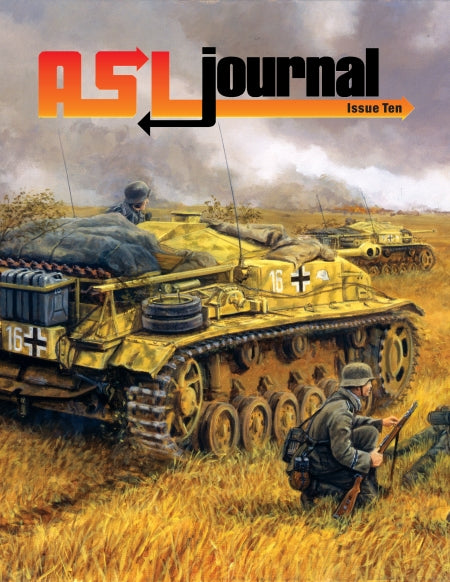Multi Man Publising
Journal #10 ASL
Journal #10 ASL
Couldn't load pickup availability
ASL Journal 10 is Multi-Man Publishing’s magazine for Advanced Squad Leader and features six brand-new articles, the latest Q&A/errata, sixteen ASL scenarios printed on cardstock, and two cardstock player aids.
ASL Journal 10’s new format features separate, cardstock scenarios, rather than the traditional method of binding the scenarios in with the rest of the pages, with the magazine itself now printed on the same 80-pound gloss paper we use for our Special Ops magazine. Players will no longer have to photocopy the scenarios or remove them from the magazine prior to playing, and the new glossy paper for the 48-page magazine proper will significantly improve the brightness and clarity of articles therein. Using scenario card inserts also makes it easier to include other inserts, such as the player aids also provided in ASL Journal 10.
Contents:
- Scenario Replay of the Festung Budapest scenario FB17 Stalingrad Redux, with Phil Palmer, John Slotwinski, and Sean Deller;
- Spencer Armstrong’s When In The War? is a survey of date-dependent rules in table format;
- Robert Wolkey aims to ease newbie pain in The Beginner Blues;
- Bruno Nitrosso’s Close Combat Simulator guides you to a better approach in CC;
- Bret Hildebran’s Son of Squad Bleeder is a DYO-esque trio of scenarios;
- Aaron Cleavin explores low-odds FP attacks and Sniper tactics in Bullet In The Head;
- Debriefing, this issue’s errata updates;
- The Umpires’ View editorial, with various “deep” thoughts from MMP HQ;
- Frequently Asked Questions for Festung Budapest;
- The Festung Budapest Player Aid Chart; and
- 16 ASL scenarios (printed on 8” x 11” cardstock):
ScenarioList:
- J147 Into The Grinding Mill (Chinese vs Japanese, 12 September, 1937)
- J148 Last Minute War (Hungarians vs Slovakians, 24 March 1939)
- J149 Taking A Stand At Rosario (Americans vs Japanese, 22 December 1941)
- J150 The Sangshak Redemption (British vs Japanese, 26 March 1944)
- J151 Squeeze Play (Japanese vs British, 25 May 1944)
- J152 Messenger Boys (German vs British, 2 August 1944)
- J153 Dawn’s Early Light (American vs German, 7 August 1944)
- J154 Cradle To Grave (American/FFI vs German, 1 September 1944)
- J155 It’s Hardly Fair (Americans vs Germans, 20 September 1944)
- J156 Mageret Mixer (Germans vs Americans, 19 December 1944)
- J157 Rage Against The Machine (Germans vs Russians, 21 December 1944)
- J158 It Don’t Come Easy (Americans vs Germans, 15 January 1945)
- J159 Tropic Lightning (Japanese vs Americans, 24 January 1945)
- J160 Bienen Burnout (Germans vs Canadians, 25 March 1945)
- VotG25 Urban Nightmare (Germans vs Russians, 28 September 1942)
- FB18 Red Banner Days (Germans/Hungarians vs Russians, 26 January 1945)
The scenarios tend somewhat towards the large: 2/3 of the J10 scenarios are large in size, with the remainder divided between small and medium. Four scenarios have some form of OBA, one scenario uses Air Support, and one scenario uses the Night rules. That scenario is a Valor of the Guards scenario, the tiny VotG25 (Urban Nightmare). There is also a (much larger) Festung Budapest scenario, FB18 (Red Banner Days). Scenario J158 (It Don’t Come Easy) is a DASL scenario. One of the scenarios, J149 (Taking a Stand at Rosario), is a reprint of an earlier Dispatches from the Bunker scenario. J160 (Bienen Burnout) uses ASLSK boards
One of the early favorites to emerge from Journal #10 is J157 (Rage against the Machine), a Soviet-German scenario that teeters on the edge of tournament playability (it is probably a tad too large, except for speedy players). This scenario was designed by Peter Struijf and Chris Mazzei, who have contributed a number of scenarios to the Journal and to Friendly Fire packs in the past. The scenario is balanced and fun. They also designed a very interesting PTO scenario, J147 (Into the Grinding Mill), which features a large Japanese attack (including a flamethrower, DCs, and 5 tanks) against a fortified Chinese position.
J159 (Tropic Lightning) is another meaty PTO scenario designed by the Bongiovanni brothers. It features a seriously powerful American force attacking a far weaker Japanese force, but the Americans face daunting victory conditions. J150 (The Sangshak Redemption) is a tournament-sized PTO scenario that might see significant play. A company-sized Japanese force have to attack a reinforced Indian platoon, then withstand a major counterattack by a truly nasty Gurkha force. Unfortunately, another tournament-sized PTO action, J151 (Squeeze Play), though it features an interesting situation, is probably too unbalanced to play–the defending Japanese have too few forces to defend a fairly large area and the attacking British, who also have a flamethrower and 4 Lee tanks, can range across the battlefield causing havoc. The Japanese balance probably wouldn’t help them much, either (instead of the listed balance, players might try adding a Japanese 4-4-7).
Pete Shelling’s tournament-sized J156 (Mageret Mixer) ought to receive a lot of play; not only does it seem balanced, but it includes one of the best SSRs in the magazine. In this scenario, the German player places four Pz IVJ wrecks on the mapboard (in pre-designated places). However, one of these wrecks–determined randomly–is not really a wreck and will “wake up” mid-game, perhaps to the dismay of the American player, depending on which of the wrecks wakes up. Shelling also contributed the more meaty J154 (Cradle to Grave), which features a mixed American/FFI (French maquis) force defending against a German attack (the “mysterious maquis known only as ‘Captain Clin'” mentioned in the scenario aftermath was actually Maurice Colin).
ASL Journal 10 scenarios use the following boards and overlays:
Boards: 4, 10, 11, 12, 13, 18, 24, 35, 39, 40, 41, 42, 44, 46, 48, 49, 50, 54, 56, 64, 65, 2a, 3a, b, c, d, FB(NE), FB(NW), VotG, x, y
Overlays: O1, O4, O5, OW1, Wd1, Wd2, Wd4, X11, X14, X15, X16, X18, X22, X27, X29

